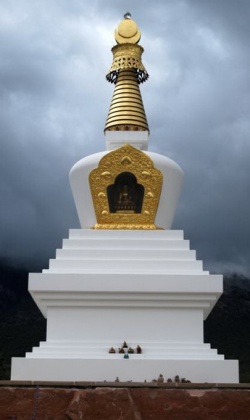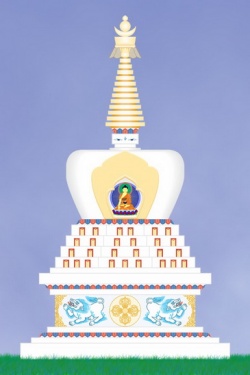Difference between revisions of "What is a Stupa?"
(Created page with "thumb|250px| <poem> A stupa is a symbol of enlightenment and is one of the most ancient icons of Buddhist art. Stupas are also the oldest and most prev...") |
|||
| Line 1: | Line 1: | ||
[[File:Stupa-001.jpg|thumb|250px|]] | [[File:Stupa-001.jpg|thumb|250px|]] | ||
<poem> | <poem> | ||
| − | A stupa is a symbol of enlightenment and is one of the most ancient icons of Buddhist art. Stupas are also the oldest and most prevalent forms of Buddhist architecture. More than just being examples of art and architecture, these holy monuments were designed with deep symbolism and sacred geometry. Filled with Buddhist relics, and other holy objects, stupas emanate blessings and peace. | + | A [[stupa]] is a [[symbol]] of [[enlightenment]] and is one of the most ancient icons of [[Buddhist]] [[art]]. [[Stupas]] are also the oldest and most prevalent [[forms]] of [[Buddhist architecture]]. More than just [[being]] examples of [[art]] and architecture, these holy monuments were designed with deep [[symbolism]] and [[sacred]] geometry. Filled with [[Buddhist]] [[relics]], and other holy [[objects]], [[stupas]] [[emanate]] [[blessings]] and [[peace]]. |
| − | A stupa is the most sacred monument found in all of the ancient Buddhist countries. Unique amongst all forms of sacred architecture, it is the quintessential symbol of enlightenment. Stupas are filled with sacred images, mantras and the relics of holy beings. The foundation, symmetry, orientation and contents of the stupa create incredible power to those who even look upon it. It has the potential to transcend the limitations of language to activate enlightened knowledge. | + | A [[stupa]] is the most [[sacred]] monument found in all of the ancient [[Buddhist]] countries. Unique amongst all [[forms]] of [[sacred]] architecture, it is the quintessential [[symbol]] of [[enlightenment]]. [[Stupas]] are filled with [[sacred]] images, [[mantras]] and the [[relics]] of holy [[beings]]. The [[foundation]], {{Wiki|symmetry}}, orientation and contents of the [[stupa]] create incredible [[power]] to those who even look upon it. It has the potential to transcend the limitations of [[language]] to activate [[enlightened]] [[knowledge]]. |
| − | “A stupa is a place where all the Buddhas are abiding. Those beings who don’t have the karma actually to see Buddha need the holy objects of body, speech and mind - statues, scriptures, stupas - as a field for accumulating merit.” - Guhyasamaja Root Text | + | “A [[stupa]] is a place where all the [[Buddhas]] are abiding. Those [[beings]] who don’t have the [[karma]] actually to see [[Buddha]] need the holy [[objects]] of [[body]], [[speech]] and [[mind]] - [[statues]], [[scriptures]], [[stupas]] - as a field for accumulating [[merit]].” - [[Guhyasamaja]] [[Root]] Text |
| − | The Symbolic Meaning of Stupas | + | The [[Symbolic]] Meaning of Stupas |
| − | The various components of a stupa represent the following: | + | The various components of a [[stupa]] represent the following: |
| − | 1. The basic platform that “holds the | + | 1. The basic platform that “holds the [[earth]]” [[symbolizes]] the ten [[virtues]] of: |
Body: | Body: | ||
* Protecting life | * Protecting life | ||
* Practicing generosity | * Practicing generosity | ||
| − | * Keeping pure morality | + | * Keeping [[pure]] morality |
Speech: | Speech: | ||
| Line 26: | Line 26: | ||
Mind: | Mind: | ||
* Practicing contentment | * Practicing contentment | ||
| − | * Being altruistic | + | * [[Being]] altruistic |
| − | * Having faith in right views (which are the correct foundation for liberation) | + | * Having [[faith]] in [[right views]] (which are the correct [[foundation]] for [[liberation]]) |
| − | 2. The three steps above symbolize the three refuges one holds on to: | + | 2. The three steps above [[symbolize]] the [[three refuges]] one holds on to: |
* Buddha | * Buddha | ||
* Dharma | * Dharma | ||
* Sangha | * Sangha | ||
| − | 3. The lion throne symbolizes superiority over the whole universe and, in particular, the four fearlessnesses, which are a result of the four knowledges: | + | 3. The [[lion throne]] [[symbolizes]] superiority over the whole [[universe]] and, in particular, the [[four fearlessnesses]], which are a result of the four knowledges: |
| − | * Knowledge that all factors of existence are understood | + | * [[Knowledge]] that all factors of [[existence]] are understood |
| − | * Knowledge that the obstacles are correctly known and the way to stop them can be taught to others | + | * [[Knowledge]] that the obstacles are correctly known and the way to stop them can be taught to others |
| − | * Knowledge that the path of renunciation, through which all the virtuous qualities are obtained, has in fact been accomplished | + | * [[Knowledge]] that the [[path]] of [[renunciation]], through which all the [[virtuous]] qualities are obtained, has in fact been accomplished |
| − | * Knowledge that all corruption has been brought to an end | + | * [[Knowledge]] that all corruption has been brought to an end |
| − | 4. The treasure vase symbolizes the eight precious royal objects (eight noble riches) | + | 4. The [[treasure vase]] [[symbolizes]] the eight [[precious]] {{Wiki|royal}} [[objects]] (eight [[noble]] riches) |
| − | 5. The small and the big lotuses symbolize the six transcendental virtues (six perfections): | + | 5. The small and the big [[lotuses]] [[symbolize]] the six [[transcendental]] [[virtues]] (six perfections): |
* Generosity | * Generosity | ||
| − | * Morality (ethics) | + | * [[Morality]] (ethics) |
* Patience | * Patience | ||
| − | * Energy (enthusiastic perseverance) | + | * [[Energy]] ({{Wiki|enthusiastic}} perseverance) |
* Meditation | * Meditation | ||
| − | * Wisdom | + | * [[Wisdom]] |
[[File:Osel-stupa.jpg|thumb|250px|]] | [[File:Osel-stupa.jpg|thumb|250px|]] | ||
| − | 6. The four corners of the basic throne symbolize the four immeasurables: | + | 6. The four corners of the basic throne [[symbolize]] the four immeasurables: |
| − | * Immeasurable love | + | * [[Immeasurable]] love |
| − | * Immeasurable compassion | + | * [[Immeasurable]] compassion |
| − | * Immeasurable joy | + | * [[Immeasurable]] joy |
| − | * Immeasurable equanimity | + | * [[Immeasurable]] [[equanimity]] |
| − | 7. The first step symbolizes the four mindfulnesses: | + | 7. The first step [[symbolizes]] the four mindfulnesses: |
| − | * Mindfulness of the body | + | * [[Mindfulness]] of the body |
| − | * Mindfulness of feelings | + | * [[Mindfulness]] of feelings |
| − | * Mindfulness of the non-substantiality of thoughts | + | * [[Mindfulness]] of the [[non-substantiality]] of thoughts |
| − | * Mindfulness of the condition of existence (dharmas) | + | * [[Mindfulness]] of the [[condition]] of [[existence]] ([[dharmas]]) |
| − | 8. The second step symbolizes the four perfect efforts (sammapadhana): | + | 8. The second step [[symbolizes]] the four perfect efforts (sammapadhana): |
| − | * Striving to preserve existing favourable conditions | + | * Striving to preserve [[existing]] [[favourable]] conditions |
| − | * Striving to produce such conditions not yet existing | + | * Striving to produce such [[conditions]] not yet existing |
| − | * Striving to ward off existing unfavorable conditions | + | * Striving to ward off [[existing]] unfavorable conditions |
| − | * Striving to make it impossible for such conditions to arise | + | * Striving to make it impossible for such [[conditions]] to arise |
[[File:948.JPG|thumb|250px|]] | [[File:948.JPG|thumb|250px|]] | ||
| − | 9. The third step symbolizes the four miraculous feats (riddhipada): | + | 9. The third step [[symbolizes]] the four miraculous feats (riddhipada): |
* Intention | * Intention | ||
* Thought | * Thought | ||
| Line 74: | Line 74: | ||
* Anaysis | * Anaysis | ||
| − | 10. The fourth step symbolizes the five powers (indriya): | + | 10. The fourth step [[symbolizes]] the [[five powers]] (indriya): |
* The faculty of faith | * The faculty of faith | ||
* The faculty of energy | * The faculty of energy | ||
* The faculty of attention | * The faculty of attention | ||
* The faculty of concentration | * The faculty of concentration | ||
| − | * The faculty of knowledge | + | * The faculty of [[knowledge]] |
| − | 11. The unchanging base that supports the vase symbolizes the five forces (bala): | + | 11. The [[unchanging]] base that supports the vase [[symbolizes]] the five forces (bala): |
* The force of faith | * The force of faith | ||
* The force of energy | * The force of energy | ||
* The force of attention | * The force of attention | ||
* The force of concentration | * The force of concentration | ||
| − | * The force of knowledge | + | * The force of [[knowledge]] |
[[File:Veltsa talvel .JPG|thumb|250px|]] | [[File:Veltsa talvel .JPG|thumb|250px|]] | ||
| − | 12. The vase in its particularities symbolizes the seven branches of awakening (bodhyanga): | + | 12. The vase in its particularities [[symbolizes]] the seven branches of [[awakening]] (bodhyanga): |
| − | * Total memory (or past lives) | + | * Total [[memory]] (or past lives) |
| − | * Perfect knowledge of all dharmas | + | * [[Perfect knowledge]] of all dharmas |
* Diligence | * Diligence | ||
* Ecstasy | * Ecstasy | ||
| − | * Perfect mastery of all disciplines | + | * Perfect [[mastery]] of all disciplines |
* Concentration | * Concentration | ||
| − | * Equanimity | + | * [[Equanimity]] |
| − | 13. The “tre” (“Harmika” above the vase) and its reverse symbolize the noble eightfold path: | + | 13. The “tre” (“Harmika” above the vase) and its reverse [[symbolize]] the [[noble]] eightfold path: |
* Perfect view | * Perfect view | ||
* Perfect understanding | * Perfect understanding | ||
| Line 105: | Line 105: | ||
* Perfect effort | * Perfect effort | ||
* Perfect attention | * Perfect attention | ||
| − | * Perfect concentration | + | * Perfect [[concentration]] |
| − | 14. The tree of life (sog shing) symbolizes the ten knowledges of phenomena: | + | 14. The [[tree]] of [[life]] (sog shing) [[symbolizes]] the ten [[knowledges]] of phenomena: |
| − | * Mind (the thoughts of others) | + | * [[Mind]] (the [[thoughts]] of others) |
| − | * Interdependent links | + | * [[Interdependent]] links |
| − | * Empirical knowledge | + | * [[Empirical]] knowledge |
* Suffering | * Suffering | ||
* The origin of suffering | * The origin of suffering | ||
| − | * The cessation of suffering | + | * The [[cessation]] of suffering |
| − | * The path leading to the cessation of suffering | + | * The [[path]] leading to the [[cessation]] of suffering |
* Things that lead to despair | * Things that lead to despair | ||
* The non-production of things | * The non-production of things | ||
15. The thirteen rings symbolize: | 15. The thirteen rings symbolize: | ||
| − | * The ten powers (or alternatively, the ten bodhisattva bhumis) | + | * The [[ten powers]] (or alternatively, the ten [[bodhisattva]] bhumis) |
| − | * The three essential remembrances | + | * The three [[essential]] remembrances |
</poem> | </poem> | ||
{{R}} | {{R}} | ||
Revision as of 09:19, 7 September 2013
A stupa is a symbol of enlightenment and is one of the most ancient icons of Buddhist art. Stupas are also the oldest and most prevalent forms of Buddhist architecture. More than just being examples of art and architecture, these holy monuments were designed with deep symbolism and sacred geometry. Filled with Buddhist relics, and other holy objects, stupas emanate blessings and peace.
A stupa is the most sacred monument found in all of the ancient Buddhist countries. Unique amongst all forms of sacred architecture, it is the quintessential symbol of enlightenment. Stupas are filled with sacred images, mantras and the relics of holy beings. The foundation, symmetry, orientation and contents of the stupa create incredible power to those who even look upon it. It has the potential to transcend the limitations of language to activate enlightened knowledge.
“A stupa is a place where all the Buddhas are abiding. Those beings who don’t have the karma actually to see Buddha need the holy objects of body, speech and mind - statues, scriptures, stupas - as a field for accumulating merit.” - Guhyasamaja Root Text
The Symbolic Meaning of Stupas
The various components of a stupa represent the following:
1. The basic platform that “holds the earth” symbolizes the ten virtues of:
Body:
- Protecting life
- Practicing generosity
- Keeping pure morality
Speech:
- Telling the truth
- Reconciling others
- Speaking in a quiet and gentle way
- Speaking sensibly and meaningfully
Mind:
- Practicing contentment
- Being altruistic
- Having faith in right views (which are the correct foundation for liberation)
2. The three steps above symbolize the three refuges one holds on to:
- Buddha
- Dharma
- Sangha
3. The lion throne symbolizes superiority over the whole universe and, in particular, the four fearlessnesses, which are a result of the four knowledges:
- Knowledge that all factors of existence are understood
- Knowledge that the obstacles are correctly known and the way to stop them can be taught to others
- Knowledge that the path of renunciation, through which all the virtuous qualities are obtained, has in fact been accomplished
- Knowledge that all corruption has been brought to an end
4. The treasure vase symbolizes the eight precious royal objects (eight noble riches)
5. The small and the big lotuses symbolize the six transcendental virtues (six perfections):
- Generosity
- Morality (ethics)
- Patience
- Energy (enthusiastic perseverance)
- Meditation
- Wisdom
6. The four corners of the basic throne symbolize the four immeasurables:
- Immeasurable love
- Immeasurable compassion
- Immeasurable joy
- Immeasurable equanimity
7. The first step symbolizes the four mindfulnesses:
- Mindfulness of the body
- Mindfulness of feelings
- Mindfulness of the non-substantiality of thoughts
- Mindfulness of the condition of existence (dharmas)
8. The second step symbolizes the four perfect efforts (sammapadhana):
- Striving to preserve existing favourable conditions
- Striving to produce such conditions not yet existing
- Striving to ward off existing unfavorable conditions
- Striving to make it impossible for such conditions to arise
9. The third step symbolizes the four miraculous feats (riddhipada):
- Intention
- Thought
- Perseverance
- Anaysis
10. The fourth step symbolizes the five powers (indriya):
- The faculty of faith
- The faculty of energy
- The faculty of attention
- The faculty of concentration
- The faculty of knowledge
11. The unchanging base that supports the vase symbolizes the five forces (bala):
- The force of faith
- The force of energy
- The force of attention
- The force of concentration
- The force of knowledge
12. The vase in its particularities symbolizes the seven branches of awakening (bodhyanga):
- Total memory (or past lives)
- Perfect knowledge of all dharmas
- Diligence
- Ecstasy
- Perfect mastery of all disciplines
- Concentration
- Equanimity
13. The “tre” (“Harmika” above the vase) and its reverse symbolize the noble eightfold path:
- Perfect view
- Perfect understanding
- Perfect speech
- Perfect action
- Perfect living
- Perfect effort
- Perfect attention
- Perfect concentration
14. The tree of life (sog shing) symbolizes the ten knowledges of phenomena:
- Mind (the thoughts of others)
- Interdependent links
- Empirical knowledge
- Suffering
- The origin of suffering
- The cessation of suffering
- The path leading to the cessation of suffering
- Things that lead to despair
- The non-production of things
15. The thirteen rings symbolize:
- The ten powers (or alternatively, the ten bodhisattva bhumis)
- The three essential remembrances




